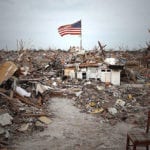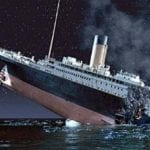 Weird Stuff
Weird Stuff  Weird Stuff
Weird Stuff  Health
Health Ten Confounding New Inventions from the World of Biomedicine
 Creepy
Creepy 10 Death Superstitions That Will Give You the Creeps
 Movies and TV
Movies and TV 10 Movies That Get Elite Jobs Right, According to Experts
 Weird Stuff
Weird Stuff 10 Times Real Laws Were Based on Bizarre Hypotheticals
 Animals
Animals 10 Inspiring Tales of Horses Being Human
 Mysteries
Mysteries Top 10 Haunting Facts About the Ghost Ship MV Alta
 History
History 10 Surprising Stories About the Texas Rangers
 Humans
Humans 10 Philosophers Who Were Driven Mad by Their Own Theories
 Miscellaneous
Miscellaneous 10 Video-Game-Worthy Weapons and Armors from History
 Weird Stuff
Weird Stuff 10 Warning Labels That Exist Because Someone Actually Tried It
 Health
Health Ten Confounding New Inventions from the World of Biomedicine
 Creepy
Creepy 10 Death Superstitions That Will Give You the Creeps
Who's Behind Listverse?

Jamie Frater
Head Editor
Jamie founded Listverse due to an insatiable desire to share fascinating, obscure, and bizarre facts. He has been a guest speaker on numerous national radio and television stations and is a five time published author.
More About Us Movies and TV
Movies and TV 10 Movies That Get Elite Jobs Right, According to Experts
 Weird Stuff
Weird Stuff 10 Times Real Laws Were Based on Bizarre Hypotheticals
 Animals
Animals 10 Inspiring Tales of Horses Being Human
 Mysteries
Mysteries Top 10 Haunting Facts About the Ghost Ship MV Alta
 History
History 10 Surprising Stories About the Texas Rangers
 Humans
Humans 10 Philosophers Who Were Driven Mad by Their Own Theories
 Miscellaneous
Miscellaneous 10 Video-Game-Worthy Weapons and Armors from History
10 Horrifying Railroad Bridge Disasters
Many would agree that traveling by train is a far more relaxing experience than taking to the highway. Once aboard a railroad car, you don’t have to drive, look at a map, or curse the carelessness of other drivers. And trains are much safer than cars. Take the year 2021. During those twelve months, a total of three people died in railroad accidents. In stark contrast, 43,000 lost their lives on America’s roads.
But railroad travel is not always safer. We’ve dug out 10 rail disasters from throughout the years, which resulted in a total of more than 800 deaths, not to mention the many injured. Each one of these horrible accidents has one factor in common: railroad bridges. So if you find such railway bridges a little scary, you’re not being entirely irrational.
Related: 10 Shocking Man-Made Disasters
10 Münchenstein Bridge—1891
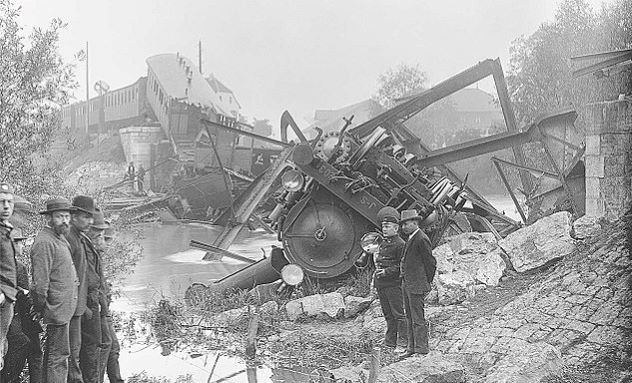
Most people probably think of Switzerland as a well-regulated nation where things generally run like clockwork. But that legendary stability was for once utterly shattered on a pleasant June afternoon in 1891. A packed train had left the city of Basel at 2:15 pm. All seemed well as the train pulled by two engines steamed onto the Münchenstein Bridge.
But as the leading locomotive began to cross the bridge, it suddenly toppled over the edge, skewed at a right angle, and plunged into the river. The second locomotive followed it into the water, as did the seven crowded passenger cars. The cars were made of lightweight wood, breaking apart after the plunge, a factor that undoubtedly contributed to the appalling death toll of 71 and the number of injured at 171. It was and remains Switzerland’s worst-ever rail disaster.[1]
9 Tay Bridge—1879
The Tay Rail Bridge opened in 1878, spanning the almost two-mile (3.2-kilometer) width of the Firth of Tay, the river estuary that flows to the North Sea. The bridge’s northern end brought the railroad into the Scottish city of Dundee. After its opening, less than two years were to pass before disaster struck on a December evening in 1879 during a violent storm featuring exceptionally high winds.
As a train crossed the bridge’s 85 spans at 7:15 pm, some of those near the center gave way, and six carriages fell into the wintery waters of the Tay. Seventy-five people died in the accident. A subsequent Court of Enquiry found that “The fall of the bridge was occasioned by the insufficiency of the cross bracing and its fastenings to sustain the force of the gale.” In other words, an engineering failure. A replacement bridge was opened in 1887 and stands to this day.[2]
8 Whangaehu River Bridge—1953
The Whangaehu River flows across New Zealand’s North Island, and on Christmas Eve 1953, flooding had swollen its waters. The events of that night gave the Maori name of a town on the river, Tangiwai, a horrible relevance. The name translates as “weeping waters,” and it was the site of a horrendous accident.
As the Wellington to Auckland express carrying 285 passengers crossed the bridge over the Whangaehu at Tangiwai, the structure of the crossing collapsed, hurling the engine and carriages into the water below. This resulted in 151 deaths. Many aboard the train had been on their way home for Christmas, and in a macabre twist, brightly wrapped Christmas gifts lay intermingled with the ghastly wreckage of the train.[3]
7 The Springbrook Bridge—1859
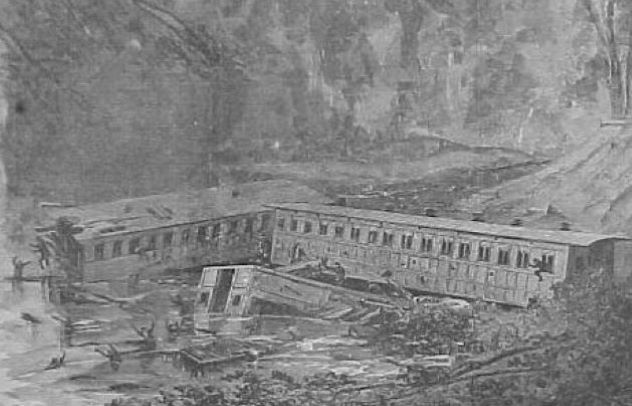
On June 27, 1859, some 150 passengers were aboard a Michigan Southern Railroad night express which had departed Chicago bound for Toledo. Not long before midnight, the train traveled through South Bend. It was traveling slowly, less than 20 mph (32.2 km/h), as it approached the Springbrook Bridge. Normally, this bridge crossed over a ravine with a tiny stream, one that quite often dried out altogether.
But on this June night, heavy rain had fallen, transforming the stream into a raging torrent. The force of the flow undermined and collapsed an embankment that supported the bridge, causing its collapse. The express train plummeted into the ravine, and according to a contemporary report in the Chicago Journal, the carriages “were shattered almost into kindling wood.” At least 60 passengers lost their lives, with many bodies only found days afterward as they’d been tumbled downstream.[4]
6 Bold Street Bridge—1977
Australia’s worst-ever train accident came in 1977, and on its 40th anniversary, the BBC dramatically headlined it, “The rail disaster that changed Australia.” Early on a January morning, a train carrying 469 travelers set off from Mount Victoria in the Blue Mountains. A couple hours after its departure, the train, pulled by an electric engine, approached the Bold Street Road Bridge in Granville.
Before it reached the bridge, the locomotive and two cars left the rails on a bend and smashed into the structure of the Bold Street crossing. The impact killed eight people. Concrete sections of the road bridge, all 518 tons (470 tonnes) of them, collapsed onto the train, crushing it almost flat in places and causing many more casualties. By the time an arduous and distressing rescue operation had finished, the final death toll was 83, with a further 213 injured.[5]
5 Ashtabula Bridge—1876
Ashtabula, Ohio, was the scene of a hideous railroad accident during a winter blizzard in December 1876. A Pacific Express train, hauled by two locomotives, was running from Buffalo to Cleveland with around 160 passengers in 11 railroad carriages. As the first engine crossed the Ashtabula Bridge, the driver heard a terrifying crack. He increased his speed and made it across the first span.
That first engine had reached safety. But the rest of the train detached from it and tumbled 70 feet (21 meters) into the Ashtabula River. While fires fueled by smashed oil lamps broke out, some passengers managed to escape by breaking out the carriage windows and clambering out. In the chaos and carnage, there was some difficulty in reaching a precise fatality figure. But in the end, the number of deaths was estimated at between 92 and 97.[6]
4 Gasconade Bridge—1855
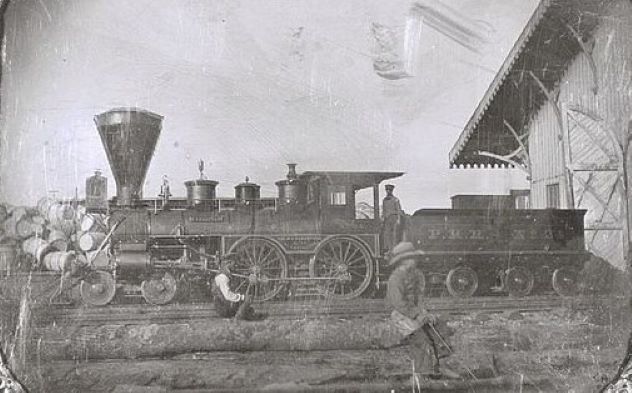
November 1, 1855, was a red-letter day in St. Louis because the train was departing for Jefferson City on the Pacific Railroad for the very first time. Some 600 of the great and the good were on board the train as it steamed out of the St. Louis station. The passengers’ spirits were hardly dampened by the heavy rain that fell as the train made its way to Jefferson City.
But it was this rain that was the cause of the terrible fate that awaited the train. The locomotive edged gingerly onto the wooden structure of the Gasconade Bridge, traveling at just 12 mph (19.3 km/h). Even so, the trestle structure crumpled, and the train was hurled into the swollen Gasconade River below. In fact, the trestle structure was a temporary fix put in place because the bridge hadn’t actually been completed properly. Thirty-one lost their lives in this railroad celebration that turned into a grim disaster.[7]
3 Eden Train Wreck—1904
On a stormy night in August 1904, a Denver and Rio Grande Railroad express was making its way south from Colorado Springs to Pueblo. Given the poor conditions, the train’s engineer was proceeding with caution, keeping his speed no higher than 20 mph (32.2 km/h). However, catastrophe struck as the locomotive and its carriages crossed the unromantically named Bridge #110B.
The engine just managed to clear the bridge as it gave way, but it was dragged back into the waters below along with several cars. The death toll was 96. Astonishingly, the bridge was rebuilt immediately, with the remains of the wreckage still strewn below. Another Denver and Rio Grande Railroad express crossed the reborn Bridge #110B just 24 hours after the tragedy.[8]
2 Beloeil Bridge—1864
In June 1864, a Grand Trunk Railway train was on its way from Quebec to Montreal. This particular service was known as the “Immigrant Special” because it was heavily used by newcomers to Canada. On this day, the train had 458 souls aboard, with many of them hailing from Poland and Germany.
As the train neared the Beloeil Bridge, which crossed the Richelieu River, the engineer should have spotted a red warning light. But he apparently either didn’t see it or simply failed to react to it. That was a fatal error, to say the least. That light signaled that the swing bridge was open to allow river traffic through. The train then plunged through the open span of the bridge into the 10-foot (3-meter) deep water below. The death toll was 99 at a minimum, with another 100 injured. The engineer survived.[9]
1 Desjardins Canal Bridge—1857
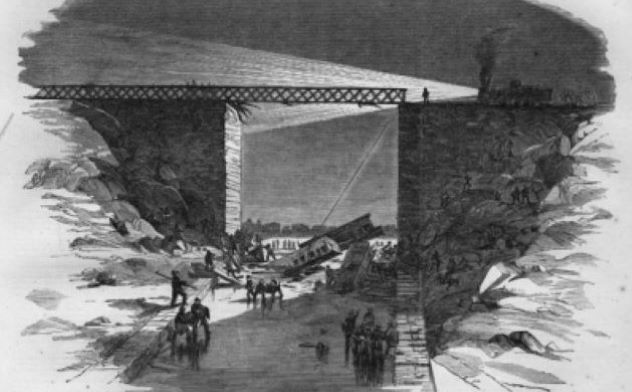
A Great Western Railway train departed from Toronto early on the morning of March 12, 1857, en route to Hamilton, where it was due to arrive in the early evening. It was proceeding at a medium speed as it approached the wooden trestle bridge that crossed the Desjardins Canal.
The waterway ran some 60 feet (18.3 meters) below the bridge in a cutting, and at the time of the accident, the canal was under two feet of ice. As the train progressed onto the crossing, the timber structure collapsed. The locomotive and its tender, plus two passenger cars, crashed down into the canal. There were some 90 passengers on the train, and 59 of them died.[10]
